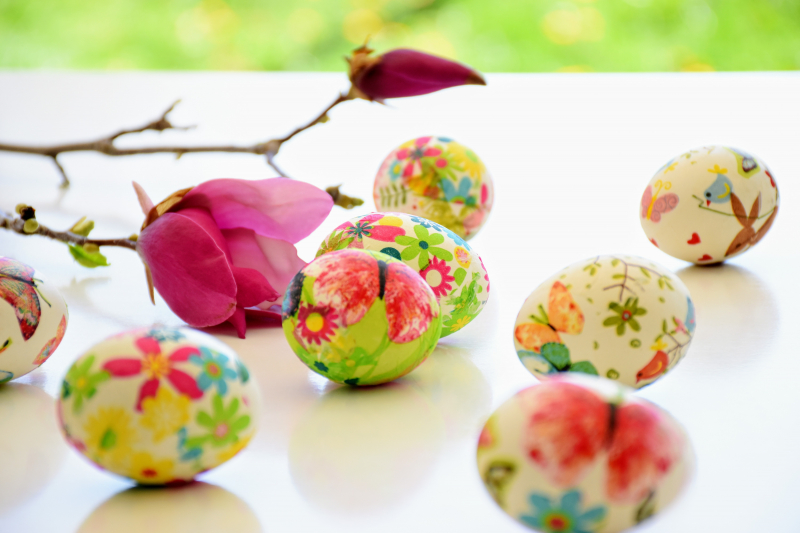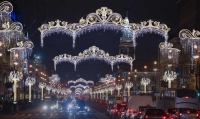Due to the Julian-Gregorian calendar case (which we described earlier in our Christmas article), Easter in Russia is celebrated a week later than in most of the countries. Because Orthodox Easter is not a fixed date like Christmas, sometimes it falls on the same date as Western Easter or the Jewish Passover.
Such rare occasions are commonly considered great dates to discuss and underline the common humanistic basis of all religions.
Russian Easter Traditions
Russian Orthodox Church considers Easter the main church celebration of the year. The root of this celebration lies in the early Christian ages (when the first Christians were persecuted by the Romans and had to take refuge in caves) when Christmas was considered as the start of Jesus’s mission as a savior and Easter as its successful completion.
We won’t go deep into details, because these Easter-centric or Christmas-centric philosophical discussions are still a hot topic even in Orthodox theology. The practical conclusion of this is that Easter worship is much more beautiful, full of different symbols and hymns, and boasts the longest church celebration of all Orthodox service practices. So, if you want to get a full insight on how the Orthodox religious practice looks like, visiting an Easter service might be a good (and a very beautiful and heartwarming) experience.
The week leading up to Easter is called “Strastnaya Nedelja,” (the Holy Week) where each day marks an important religious event. It’s the last week of Lent for religious people and also the time to think about one’s sins and pray.
Even non-religious people will often pick Holy Thursday as the day to clean house and prepare food for the celebration. Many will take their dyed eggs and sweetbreads called kulichi to be blessed at church on Saturday.
Russian Orthodox churches hold special services on Saturday nights that flow into Sunday morning, celebrating the resurrection of Christ. Each will have a procession of the Cross accompanied by bells and sacred hymns.
The week after the Easter everyone may climb any church tower and ring the church bells.
Easter Delights
Colorful Eggs
The egg is the symbol and the main ingredient of Orthodox Easter. Families enjoy colouring eggs as one of the merriest traditions of this holiday. Before the introduction of commercial food coloring, eggs were dyed by boiling them with onion skins (for a brown-red color) of with beetroot slices (gives blue color).
There are some other, less popular ways of dyeing eggs (Beware! Results might be unexpected). To make a green color, eggs are boiled with a lock of nettle or spinach, to get a light-brown colour - with walnut shells. The most exotic dyeing practice I’ve ever encountered (but never used) is boiling eggs with a piece of old-fashioned dark-blue sport cotton trunks (never worn, of course). It gives the eggs a deep-blue colour, but the safety of eating such eggs is doubtful.
Children like to create their own egg masterpieces given plenty of eggs, food coloring, covered surface, old clothing and artistic freedom.
As a true masterpiece live a short life, these ones will be ruined in an egg-crushing battle and finally eaten by the young artists and their families.
You’ve never partaken in an egg battle? Russian Easter is the perfect time to try it. Instructions: hold an egg (experienced players recommend the sharp end forward) and try to crush an egg of your opponent. Whose egg is uncrushed, wins.
World-famous Fabergé eggs were Easter gifts for the Russian royal family and, later, for the noblemen and rich people, wanting to give a precious and unique Easter gift. As for me, the eggs made by children are the more precious (and touching) gift.
Kulichi
This sweetbread containing butter, eggs, sugar, spices (cinnamon, ginger, cardamom, vanilla and clove), dried fruits and nuts, infused with rum or sugar syrup, and covered with fondant glaze, is a calorie bomb that can ruin all your workouts with one slice. But it’s worth it. Of course, you can buy it. Shops and confectionaries offer vast variety of kuliches. But the real flavour of this dish can be tasted only in the home-made edition. Every family has a genuine recipe of the “real kulich.” Of course, the most genuine is one made by my grand-grandma, but I recommend you to taste others and find the best recipe yourself. Making a kulich is a loooong process that requires lots of efforts and some magic, but when the mission is complete, you’ll be rewarded by happy eyes of your family and children.
Enjoy and forget about calories!
Paskha
Another traditional easter delight (and another way to increase your curves) is Paskha. It is made of cottage cheese (the higher percentage of fat, the better), eggs, a generous amount of butter, sugar, dried fruits, chocolate and nuts. Making of Paskha is long, but its life is short - the dish should be eaten the day after the Easter at the latest. Eating Paskha later than that might be dangerous for your health.
Easter treats generally include meat and some other dishes, but, frankly speaking, even trying three courses of the Easter food mentioned above will provide you with all of the day’s calories and you won’t be able to eat anything else this day - or even two or three days after.
Russian vs. Western Traditions
Russian Easter still has deep religious roots, so you won’t find the usual Western characters like the Easter Bunny here. There will be egg fights, but no egg hunt for little kids, and plastic eggs won’t crack open to spill out candy. Chocolate eggs are still a novelty item and not really part of the tradition. Considering that spring is just starting, families will keep their celebrations indoors and are not likely to head outside for a picnic. But the one thing in common is that in both cases you'll get to spend a quality time with people you care about and treats that have been perfected for generations.
It’s a general tradition to greet each other on Easter Sunday with “Christ has risen!” (Khristos voskres!) and to reply with “Christ has risen indeed!” (Voistinu voskres!). Friends and relatives follow this greeting with kissing each other on the cheeks three times.
Before the Revolution, when religious traditions were deeply embedded in everyday life, this greeting (including the cheek-kissing) was practically obligatory for everyone this day (even for the members of the royal family, who used to kiss all their court and servants on this day). Some festive youngsters were practicing strolling streets on the Easter day and greeting every pretty girl with “Christ has risen!” exclamation and owing her to kiss them three times.
Of course,these days no one will force you to kiss anyone this way, but usual reply to the greeting with “Christ has risen indeed!” (Voistinu voskres!) or Happy Easter, if you like, may provide friendly and festive mood for everyone.




